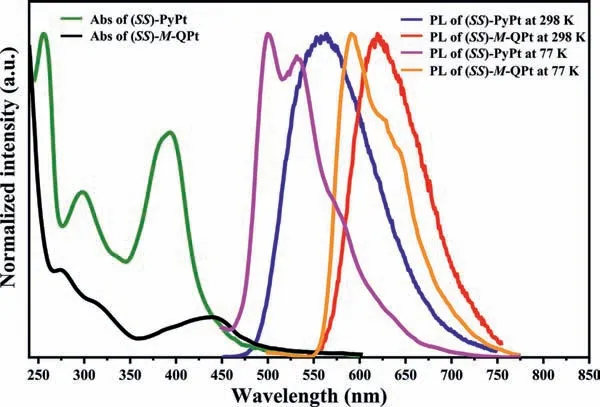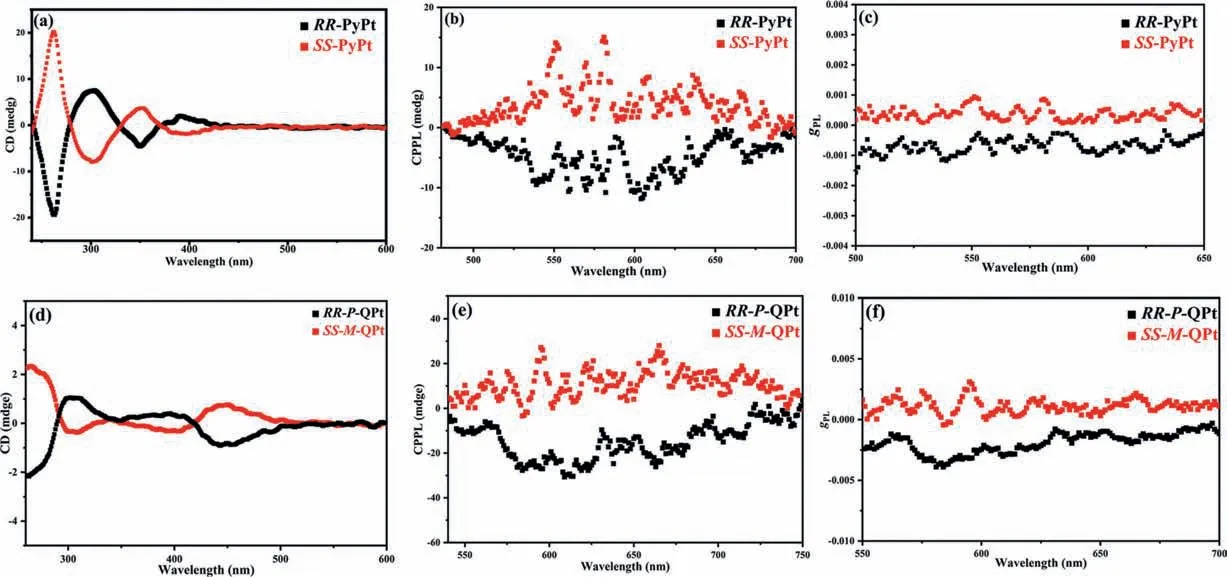Molecular self-induced configuration for improving dissymmetry factors in tetradentate platinum(II) enantiomers cycloaddition
Li Yun,Qin-Jun Ding,Zhen-Long Tu,Xing-Ji Lio,Xu-Feng Luo,Zhi-Ping Yn,Zheng-Gung Wu,You-Xun Zheng,∗
a State Key Laboratory of Coordination Chemistry,School of Chemistry and Chemical Engineering,Nanjing University,Nanjing 210023,China
b Nantong Key Lab of Intelligent and New Energy Materials,College of Chemistry and Chemical Engineering,Nantong University,Nantong 226019,China
Keywords:Pt(II) enantiomer Circularly polarized luminescence Dissymmetry factor Molecular self-induction Helicene-like structure
ABSTRACT Two pairs of Pt(II) enantiomers ((RR)/(SS)-PyPt,((RR)/(SS)-Py: N,N’-(1,2-diphenylethane-1,2-diyl)dipicolinamide;(RR)-P/M-QPt,((RR)/(SS)-Q: N,N’-((1R,2R)-1,2-diphenylethane-1,2-diyl)bis(quinoline-2-carboxamide)) were synthesized,respectively,with good circularly polarized luminescence (CPL) and tunable dissymmetry factors (g) by molecular self-induction with (RR)/(SS)-1,2-diphenylethane-1,2-diamine as carbon chiral sources.In the (RR)-P-QPt and (SS)-M-QPt,specific P- and M-configurations were effectively induced from intrinsic chiral carbon centres (R or S),ingeniously avoiding the racemic mixture formation and chiral separation.Furthermore,the chirality originating from both chiral carbon centres and helicene-like structure improves the g factor significantly,which provides a new molecular design strategy for chiral Pt(II) enantiomers with good CPL properties.
Circularly polarized light (CPL) possesses potential application in CP organic light-emitting diode (CP-OLED) and 3D display,optical data storage and optical spintronic [1,2].Circular dichroism(CD) and CPL spectra are two main detection methods for chiral materials.The CD spectrum can be employed to analyse the configuration of chiral molecules at their ground states,while CPL is used for studying chiral characteristics of their excited states.The optical activity intensity of chiral materials can be characterized by dissymmetry factor (g),and the absorptiongabsfactor is defined asgabs=Δε/ε=2(εL-εR)/(εL+εR),whereεLandεRindicate molar absorption coefficients of left and right absorption,respectively.The luminescentglumfactor is defined asglum=2ΔI/I=2(ILIR)/(IL+IR),whileILandIRrepresent the left and right CPL intensities.There is no circular polarization with thegfactor of zero,whereas factors of+2 and −2 refer to ideal highest left- or righthanded CPL,respectively.Originally,CPL can be obtained by a complicated device architecture with 1/4 slide and polarizer,resulting in brightness loss.Therefore,it is imperative to develop chiral emitters that can generate CPL directly.
In most cases,there are two main molecular design strategies for chiral luminophores: introducing stereoselectivity to realize the separation of enantiomers or endowing the molecule structure with chiral units.Carbon [3-7],axial [8-16],planar [17-20]and helical [21-23]chiral sources were commonly used.But generally,chiral carbons in these molecules are far away from luminescence centre,which do not affect CPL properties greatly.Therefore,thegfactors of these materials are at relatively low grade.Aside from chiral carbon,binaphthol derivatives with axial chirality is also often employed as well [8-15].However,these materials have same drawbacks as carbon chiral materials.Notably,helicenes do not have any asymmetric carbon centres,whereas their twisted and extendedπ-conjugated molecular structures exhibit the special helical chirality and excellent CPL properties.
However,the synthesis of helicene usually suffered from harsh reaction conditions and cumbersome operation.Moreover,the helicene-based enantiomers can be basically obtained from racemates through chiral resolution,making the preparation and separation process complicated.Therefore,developing a concise and efficient method to directly construct helical molecules with high dissymmetry factor without resolution remains a significant challenge.
Among all these chiral materials,traditional fluorescent materials can use only 25% of singlet excitons formed during the exciton recombination process,which results in lower CP-OLED efficiency.Notably,phosphorescent complexes can utilize both singlet and triplet excitons to improve the internal quantum efficiency(IQE) up to 100%.Although these materials show better device efficiency,the reportedgfactors based on transition metal (Ir(III)[24-26]or Pt(II) [27-33]) complexes are at 10−3−10−2order,which still leaves much to be desired.

Fig.1.Design strategy and synthetic routes of chiral tetradentate Pt(II) complexes.
Herein,two pairs of chiral tetradentate Pt(II) complex (Fig.1)were synthesized using chirality induction strategy to obtain highgfactors.The chirality of (RR)/(SS)-PyPt ((RR)/(SS)-Py:N,N’-(1,2-diphenylethane-1,2-diyl)dipicolinamide) is only inherited from chiral (RR)/(SS)-1,2-diphenylethane-1,2-diamine.But the chirality of (RR)-P-QPt and (SS)-M-QPt ((RR)/(SS)-Q:N,N’-((1R,2R)-1,2-diphenylethane-1,2-diyl)bis(quinoline-2-carboxamide)) originates from chiral carbon centres as well as a helicene-like structure during the platinum coordination process.It is worth noting that the |gPL| factors of (RR)-P-QPt and (SS)-M-QPt are significantly improved to around 3.5 × 10−3,five times higher than that of(RR)/(SS)-PyPt.In the (RR)-P-QPt and (SS)-M-QPt structures,the specificP- andM-configurations result from intrinsic chiral carbon centre,ingeniously avoiding the formation of racemic mixture,which means future chiral separation is of no need.
The synthetic routes of the target chiral tetradentate Pt(II) complexes and the synthesis details are provided in Supporting information.Commercially available chiral 1,2-diphenylethane-1,2-diamine is employed as reactant and the final products were obtained through only two steps.For (RR)-P-QPt and (SS)-M-QPt enantiomers,the reactant withS-configuration can only formMconfiguration specifically,avoiding enantio-separation.Therefore,the newly chirality is born from steric hindrance effect after Pt(II)ion coordination with ligand.As revealed by the thermogravimetric analysis curves (Figs.S10 and S11 in Supporting information),the decomposition temperatures are 333 and 347°C,respectively,demonstrating the high thermal stability of these Pt(II)complexes.
As shown in Fig.2,the single crystal diffraction analysis well confirmed the preconceived molecular structures.In the structures of (RR)/(SS)-PyPt,Pt(II) adopts the form of plane tetragonal coordination without any other steric hinderance existing,therefore,the planes of pyridine and the three coordinated five-membered rings are almost parallel.In (RR)-P-QPt and (SS)-M-QPt,Pt(II) ion adopts analogous coordinative form,but with the steric hinderance caused by two quinoline units on each side,thus the enantiomers present more twisted structures with the angle between the two planes of quinoline is 38.3°,which is similar to the reported value in [7]helicene (hc ≈30.7°) [34].
Furthermore,(RR)-P-QPt and (SS)-M-QPt enantiomers form new spiral structures after coordination,which would effectively enhance their CPL properties andgfactors.Besides,as shown in Fig.S9 (Supporting information),the phenyl group attached to the chiral carbon and the quinoline unit at the same side must be spatially away from each other due to the steric hindrance in order to have a more stable configuration.If there were no phenyl groups existing,it should form four isomers,namely (SS)-P-QPt,(SS)-MQPt,(RR)-P-QPt and (RR)-M-QPt.Therefore,the specific configurations of (RR)-P-QPt and (SS)-M-QPt enantiomers are induced by this special structure,avoiding further enantio-separation.
In CH2Cl2solutions (5 × 10−5mol/L) at room temperature,these Pt(II) complexes show strong absorption bands in the region of 250–350 nm (Fig.3),which are attributed to the spinallowed singletπ–π∗transitions of ligands.Due to the strong spin-orbital coupling effect of the Pt(II),the absorption spectra of the complexes also show a wide band ranging from 350 nm to 500 nm,which belong to the mixed singlet and triplet MLCT(metal-to-ligand charge-transfer) transitions.Alternatively,the location of the transition can also be simulated by theoretical calculations (Table S9 in Supporting information).For example,the excited state from S0to S1transition of (RR)-P-QPt is dominated by HOMO-LUMO transition,which is generated by the large conjugate quinoline system with the Pt(II) centre (Fig.S32 in Supporting information).
In addition,the photoluminescence spectra of (RR)/(SS)-PyPt at room temperature demonstrate the main emission peak at 564 nm with the Commission Internationale de L’Eclairage (CIE) coordinates of (0.44,0.54).While the photoluminescence spectra of(RR)-P-QPt and (SS)-M-QPt display the main emission peak at 616 nm with the CIE coordinates of (0.63,0.37).Therefore,the replacement of pyridine by quinoline would result in emission red-shift of the Pt(II) enantiomers.When measured at 77 K,the emission peak of (SS)-PyPt is shifted to 503 nm with a shoulder peak at 534 nm.Similarly,the emission peak of (SS)-M-QPt is moved to 594 nm with a shoulder peak at 634 nm,which could be assigned to1MLCT and3MLCT transitions [15],respectively.The absolute photoluminescence quantum yields (PLQYs) of (RR)/(SS)-PyPt and(RR)/(SS)-P/M-QPt are 6.72% and 1.99% with lifetimes of 0.14 and 0.11 μs in CH2Cl2solutions,PLQYs of 0.13 and 0.04 with lifetimes of 0.19 and 0.18 μs in neat films,respectively.The PLQYs are not as high as we expected.
To further characterize the chiroptical properties of two pairs of(RR)/(SS)-PyPt and (RR)/(SS)-P/M-QPt enantiomers,the CD and CPL spectra were investigated.As illustrated in Figs.4a and d,clear mirror-image CD spectra of the two pairs of enantiomers are observed with alternating positive and negative Cotton effects.(RR)-PyPt shows a clear positive Cotton effects at 262 and 350 nm,and negative Cotton effects at 300 and 390 nm,whereas (SS)-PyPt displays the opposite signals at the same positions.The (RR)-P-QPt and (SS)-M-QPt demonstrate similar mirror symmetric CD spectra as (RR)/(SS)-PyPt with commutative positive and negative Cotton effects.The intense Cotton effects in short-wavelength regions are assigned to absorption caused by the intramolecularπ-system CT,while the Cotton effects at the long-wavelength absorption bands are caused by the MLCT processes.
As for the CPL spectra andgPLversus wavelength curves(Figs.4b,c,e and f),(RR)-PyPt and (SS)-PyPt show symmetrical spectra at 470-700 nm with thegPLfactors of −0.77/+0.63 × 10−3in CH2Cl2solutions.Similarly,(RR)-P-QPt and (SS)-M-QPt also display symmetrical spectra at 480-750 nm.Notably,gPLfactors of (RR)-P-QPt and (SS)-M-QPt are significantly improved to−3.5 × 10−3and+3.1 × 10−3,almost five times higher than that of (RR)-PyPt and (SS)-PyPt,owing to the formation of the spiral chiral centres in (RR)-P-QPt and (SS)-M-QPt enantiomers.This phenomenon can be confirmed by the crystal packing structures of the enantiomers (Fig.2c).
Furthermore,the definition ofgfactor is given in


Fig.2.(a) Crystal structures of the enantiomers of (RR)-PyPt (CCDC:2078749),(SS)-PyPt (CCDC:2083860),(RR)-P-QPt (CCDC: 2073874) and (SS)-M-QPt (CCDC: 2073866).(b)The topview and sideview of (RR)-PyPt and (RR)-P-QPt.(c) Crystal packing of (RR)-P-QPt.

Fig.3.Normalized absorption and emission spectra of (SS)-PyPt,(SS)-M-QPt in CH2Cl2 solutions.
where→μand→mindicate the electric and magnetic dipole transition moments,respectively.According to the equation,the equal|→m| and |→μ| factors of the material would cause the biggestgfactor colse to 2.But in most chiral materials,except for lanthanide complexes,the |→m| data are much lower than that of |→μ|.Therefore,most chiral materials only show lowgfactors,less than 10−2order in most cases.
For these complexes,the theoretically calculated electric dipole moment→μfactors of (RR)-PyPt from S0to S1transition is (0.0009,−0.1459,0.0003),and the magnetic dipole moment→mis (0,−0.0093,−0.0001),thus the |→μ| and |→m| data are 0.1459 and 0.0093 respectively (Figs.S28–S31 and Tables S4–S8 in Supporting information).However,for the (RR)-P-QPt,the theoretically calculated electric dipole moment→μfrom S0to S1transition is(−0.0289,−0.0082,−0.0092),and the magnetic dipole moment→mis (0.0812,−0.0009,−0.0328),thus the |→μ| and |→m| factors are 0.0314 and 0.088,respectively.It is obvious that (RR)-P-QPt has a smaller |→μ| and a bigger |→m| than that of (RR)-PyPt,which can explain why it has highergfactor than that of (RR)-PyPt.Besides,the calculatedgabsfactor of (RR)-PyPt from S0to S1transition is positive,in accordance with the positive signal of CD spectrum at long-wavelength region.And the calculatedgabsfactor of (RR)-PQPt from S0to S1transition is negative,also in accordance with the negative signal of CD spectrum at long-wavelength region (Table S8).

Fig.4.(a) CD spectra of (RR)/(SS)-PyPt,(b) CPL spectra of (RR)/(SS)-PyPt,(c) gPL versus wavelength curves of (RR)/(SS)-PyPt,(d) CD spectra of (RR)-P-QPt and (SS)-M-QPt,(e)CPL spectra of (RR)-P-QPt and (SS)-M-QPt,(f) gPL versus wavelength curves of (RR)-P-QPt and (SS)-M-QPt in CH2Cl2 solutions.
In conclusion,two pairs of chiral tetradentate Pt(II) enantiomers were synthesized simply by a two-step reaction employing commercially available reactant.In (RR)-P-QPt and (SS)-M-QPt,the new spiral chiral centre with specific configuration was induced by the platinum coordination,which not only avoid the chiral separation process,but also greatly improve thegfactors from−0.77/+0.63 × 10−3to −3.5/+3.1 × 10−3due to the original chiral carbon centres and formed helical-like structure.This improvedgfactors phenomenon was confirmed by the enantiomers’single crystal structures and the theoretical electric and magnetic dipole transition moments calculation.This work provides a new molecular design strategy for Pt(II) enantiomers with good CPL properties and highgfactors.
Declaration of competing interest
The authors declare that they have no known competing financial interests or personal relationships that could have appeared to influence the work reported in this paper.
Acknowledgment
This research is supported by the National Natural Science Foundation of China (Nos.51773088 and 21975119).
Supplementary materials
Supplementary material associated with this article can be found,in the online version,at doi:10.1016/j.cclet.2021.08.104.
 Chinese Chemical Letters2022年3期
Chinese Chemical Letters2022年3期
- Chinese Chemical Letters的其它文章
- Direct catalytic nitrogen oxide removal using thermal,electrical or solar energy
- Construction and applications of DNA-based nanomaterials in cancer therapy
- Recent research progress of bimetallic phosphides-based nanomaterials as cocatalyst for photocatalytic hydrogen evolution
- Nanostructured materials with localized surface plasmon resonance for photocatalysis
- Recent progress of Pd/zeolite as passive NOx adsorber: Adsorption chemistry,structure-performance relationships,challenges and prospects
- Microfluidic methods for cell separation and subsequent analysis
